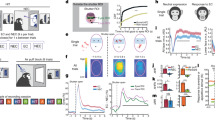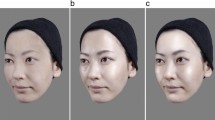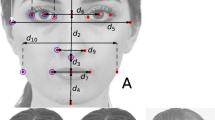Making eye contact enhances the appeal of a pleasing face, irrespective of gender.
Abstract
Faces are visual objects in our environment that provide strong social cues1, with the eyes assuming particular importance2,3. Here we show that the perceived attractiveness of an unfamiliar face increases brain activity in the ventral striatum of the viewer when meeting the person's eye, and decreases activity when eye gaze is directed away. Depending on the direction of gaze, attractiveness can thus activate dopaminergic regions that are strongly linked to reward prediction4, indicating that central reward systems may be engaged during the initiation of social interactions.
Similar content being viewed by others
Main
In an event-related functional magnetic resonance imaging (fMRI) study, 16 subjects (8 male, 8 female) were shown colour images of 40 different faces, which had their eyes directed either at or away from the subject (Fig. 1). After the fMRI scanning session, subjects rated the attractiveness of the faces they had seen, and these ratings were normalized and parametrically entered into the analysis. Significant effects (P < 0.05, corrected for multiple comparisons) were assessed using a t-test and displayed as statistical parametric maps using SPM99b software.
Faces were counterbalanced for head position, sex and, for non-eye-contact images, gaze direction (right or left). During each scanning session, subjects were presented with 2 runs of 80 faces and 40 scrambled control faces in a randomized, event-related design (new image every 3.5 s; presentation time, 1.2 s, with intervening scrambled images). No task was required from subjects while they viewed these images, but to secure and test their attention, six target images (faces with closed eyes) were included, to which subjects were asked to respond by pressing a button. In statistical analysis, these latter images were modelled as events of no interest and excluded from further evaluation. After scanning, subjects rated the attractiveness of the 40 faces on a scale from 1 to 10. There were no significant differences between ratings by male and female subjects, or between ratings on male and female faces.
No brain region showed any activation in response to facial attractiveness per se. We therefore investigated whether processing of attractiveness depends on gaze direction. When eye gaze was directed at the subjects, activity in the ventral striatum correlated positively with attractiveness (slope: + 0.46% change in signal intensity per standard deviation increase in attractiveness rating). In contrast, this correlation was reversed when eye gaze was averted, causing activity in the ventral striatum to decrease with increasing attractiveness (slope: − 0.88% signal intensity per s.d. increase in attractiveness).
Figure 2 shows the resulting activation map when these two contrasts are combined as an interaction — for example, the contrast (correlation with attractiveness when eye contact is made) minus (correlation with attractiveness when no eye contact is made). In a fixed-effects analysis, the effect was significant at a voxel level (the smallest volume tested in our study) in the right ventral striatum (P = 0.015) and at cluster level bilaterally (right, P < 0.01; left, P = 0.01). We also implemented a second-level random-effects analysis to determine whether the results could be extended to the population at large. Significant effects persisted at a cluster level in the right ventral striatum (P< 0.01; point of maximal activation: x = 12, y = − 8, z = 10) and approached significance in the left ventral striatum (P = 0.06, x = − 10, y = 0, z = 4).
When eye gaze is directed at a subject, the degree of attractiveness of individual faces correlates positively with brain activity in the ventral striatum; when eye gaze is directed away, this correlation is reversed and activity in the ventral striatum decreases with increasing attractiveness. Activation maps are superimposed on the surface of a T1-weighted template (fixed-effects analysis showing areas in which activity surpasses the threshold of P = 0.05 at the cluster level. Time to repetition, 3.16 s; 32 transverse slices; voxel size, 3 × 3 × 3 mm; Siemens VISION 2T).
The gender of the observed face in relation to the gender of the observer did not influence the response in the ventral striatum. This might indicate that features depicting attractiveness (such as facial form and symmetry) are low-level cues that are processed independently of gender.
Our results provide evidence not only that the ventral striatum processes reinforcing stimuli that serve basic survival needs5, but also that it is more generally involved in the evaluation of stimuli with relevance to social interactions. The activity of dopaminergic neurons that project to the ventral striatum is associated with reward prediction6. The firing rate of these neurons follows a specific pattern, increasing when an unexpected reward is seen and decreasing when an expected reward fails to materialize, thereby predicting error in future rewards.
In accordance with this specific pattern, we found no activation associated with attractiveness per se, but only as an interaction with eye gaze. Assuming that the dimension of attractiveness constitutes a reward, especially when social interaction is initiated, returned eye gaze from an attractive face represents a more favourable result than expected, leading to enhanced responses, whereas failing to make eye contact with an attractive face is a disappointing outcome, leading to reduced activity in the dopaminergic target systems. Likewise, eye gaze from an unattractive face may result in disappointment and a reduced response, whereas missing eye contact with an unattractive face may be a relief and thus enhance activity. The profile of the response we describe here may reflect an automatic evaluation of the likely reward that can be derived from conspecifics.
References
Bruce, V. & Young, A. Br. J. Psychol. 77, 305–327 (1986).
Kleinke, C. L. Psychol. Bull. 100, 78–100 (1986).
Emery, N. J. Neurosci. Biobehav. Rev. 24, 581–604 (2000).
Schultz, W., Dayan, P. & Montague, P. R. Science 275, 1593–1599 (1997).
Berridge, K. C. Neurosci. Biobehav. Rev. 20, 1–25 (1996).
Schultz, W. J. Neurophysiol. 80, 1–27 (1998).
Author information
Authors and Affiliations
Corresponding author
Rights and permissions
About this article
Cite this article
Kampe, K., Frith, C., Dolan, R. et al. Reward value of attractiveness and gaze. Nature 413, 589 (2001). https://doi.org/10.1038/35098149
Issue Date:
DOI: https://doi.org/10.1038/35098149
This article is cited by
-
Sharing and Receiving Eye-Contact Predicts Mate Choice After a 5-Minute Conversation: Evidence from a Speed-Dating Study
Archives of Sexual Behavior (2024)
-
A computational approach to investigating facial attractiveness factors using geometric morphometric analysis and deep learning
Scientific Reports (2023)
-
The scarcity of beauty: how and why product aesthetics mobilize consumer acquisition effort
Journal of the Academy of Marketing Science (2023)
-
Human brain activity reflecting facial attractiveness from skin reflection
Scientific Reports (2021)
-
It was a Pleasure Meeting You
International Journal of Social Robotics (2021)
Comments
By submitting a comment you agree to abide by our Terms and Community Guidelines. If you find something abusive or that does not comply with our terms or guidelines please flag it as inappropriate.





